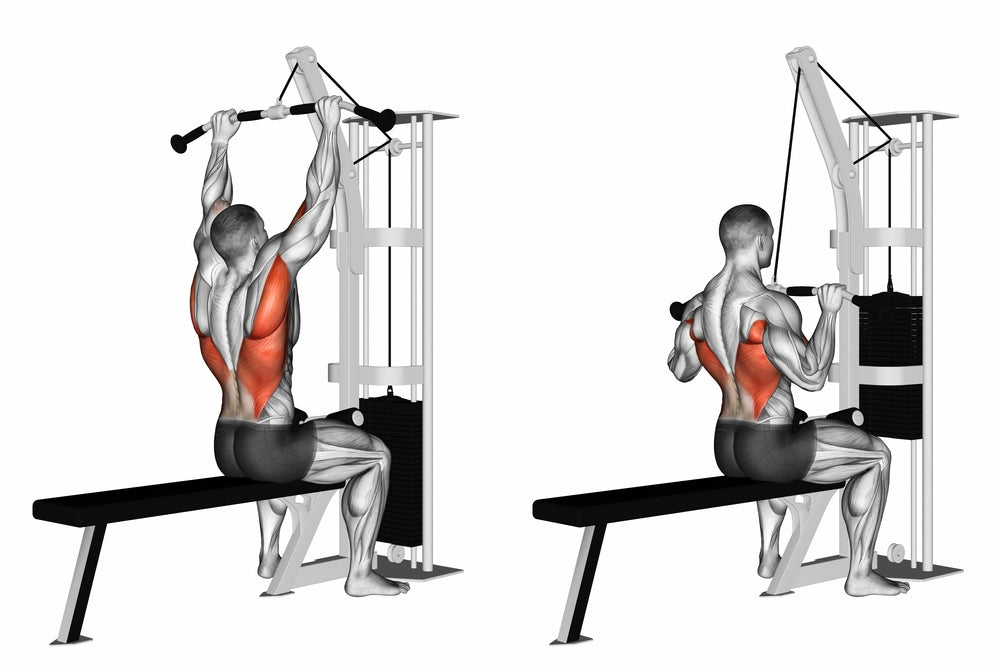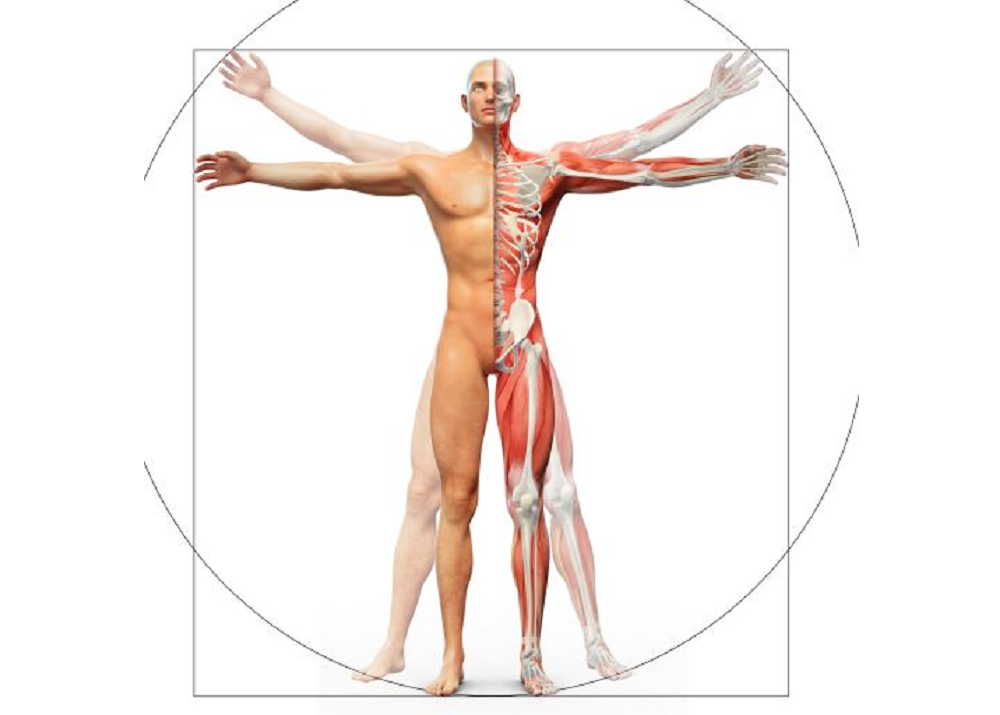Exercise Anatomy
LAT PULLDOWN
The Lat Pull-down is a highly effective exercise for targeting the muscles in your upper back, particularly the latissimus dorsi. It helps improve overall upper body strength and enhances the appearance of a V-shaped torso. A unique aspect of this exercise is its adaptability to different grip variations, allowing you to emphasize various muscles in the back. Including Lat Pull-downs in your routine contributes to better posture, a stronger back, and a sculpted physique.

Major Muscles and Actions Involved
pronated wide grip variant
The Lat Pull-down with a pronated wide grip primarily involves the shoulder joint and the elbow joint. As you initiate the movement, shoulder extension occurs, where your arms move downward from an elevated position. Simultaneously, your elbows flex, bringing the bar down towards your upper chest. The main muscles engaged in this exercise include the latissimus dorsi, teres major, rhomboids, and the posterior deltoids. The wide pronated grip emphasizes the outer portion of the lats, contributing to a broader and more defined back.

Major Muscles and Actions Involved
narrow neutral grip variant
The Lat Pull-down with a narrow neutral grip primarily targets the shoulder joint and the elbow joint. During the movement, shoulder adduction and elbow flexion occur as you pull the bar down towards the upper chest. This exercise engages muscles such as the latissimus dorsi, teres major, rhomboids, and the posterior deltoids. The narrow neutral grip emphasizes the middle portion of the lat muscles, contributing to overall back width and thickness.
EXERCISE EXECUTION
For the Lat Pull-down, start by adjusting the thigh pad and seat height on the cable machine to ensure stability. Sit with your thighs snugly secured under the pads, maintaining a straight back and a neutral spine. Grasp the bar with a wide, overhand grip, hands slightly wider than shoulder-width apart.
Initiate the movement by depressing your shoulder blades and pulling the bar down towards your upper chest in a controlled manner. Focus on engaging your lats throughout the descent and ascent. Keep your torso stationary, avoiding excessive leaning back or using momentum.
Once the bar reaches chest level, pause briefly, feeling the contraction in your lats. Slowly return the bar to the starting position, allowing your arms to fully extend without locking out the elbows. Maintain a smooth and controlled pace, emphasizing the muscle engagement throughout the entire range of motion.
Remember to breathe steadily, inhaling as you raise the bar and exhaling as you bring it down. Maintain a firm grip on the bar and avoid using excessive body sway. Adjust the weight according to your strength level, ensuring a challenging yet controlled execution of the Lat Pull-down.

Safety First
For the Lat Pulldown, the most important safety consideration is maintaining proper shoulder and back alignment to prevent strain or injury. Make sure your grip on the bar is just outside shoulder width, and keep your chest up with a slight arch in your lower back throughout the exercise. As you pull the bar down, engage your lat muscles rather than relying on arm strength, and avoid pulling the bar behind your neck, as this can place unnecessary stress on your shoulders and cervical spine. Pull the bar down to your upper chest with controlled movement, ensuring you don’t use momentum or swing your body. Additionally, avoid locking out your elbows during the release phase to protect your joints.

Sports Uses
The act of pulling your arms down sideways from above your head or raising your body when your hands are secured as, for example, in climbing and when doing pull-ups, is extremely important in many sports. The action involved is shoulder joint adduction or extension. These actions are important in the execution of stunts on the rings, horizontal bar, and uneven bars in gymnastics.
The muscles and actions are also important in pulling down rebounds in basketball, and in all pulling-up actions (climbing a ladder or wall and rock climbing). They are also important for many holds in wrestling, for various phases of the pulling pushing actions used in different swimming strokes, and in rowing, especially when the elbows are down.
Exercise Tips
- Technique:
Focus on a controlled and deliberate pulling motion, engaging your lat muscles throughout. Avoid using momentum or relying on your lower back to complete the movement. Keep your chest up and shoulders back for proper form. - Range of Motion:
Aim for a full range of motion by pulling the bar down until it reaches chest level. Allow your shoulder blades to fully retract at the bottom of the movement to optimize lat activation. Avoid shortening the range, as this limits muscle engagement. - Amount of Weight Used:
Choose a weight that allows you to perform the exercise with proper form for the desired number of repetitions. It's crucial to find a balance between challenging yourself and maintaining control throughout the movement. Gradually increase weight as your strength improves. - Grip:
Experiment with different grips to target various areas of your back. For a classic Lat Pull-down, use a wide, overhand grip. Ensure your hands are slightly wider than shoulder-width apart. Maintain a firm grip without over-gripping to prevent unnecessary forearm tension. - Variations and Breathing:
Add variety to your routine by incorporating different grip variations, such as the neutral grip or reverse grip, to emphasize different muscles in the back. Focus on controlled breathing, inhaling as you raise the bar and exhaling as you bring it down. Consistent breathing enhances stability and muscle engagement.
Lat Pulldowm vs the seated row
Lat Pulldown:
- Target Muscles: Primarily targets the latissimus dorsi (lats), along with engagement of the biceps, rhomboids, and rear deltoids.
- Position: Performed in a seated position on a lat pulldown machine, pulling a bar down in front or behind the neck.
- Movement: Involves a vertical pulling motion, emphasizing the muscles responsible for adduction and extension of the shoulder joint.
- Variations: Different grip options (wide, narrow, reverse) allow for targeting various parts of the back.
Seated Row:
- Target Muscles: Focuses on the muscles of the upper back, including the rhomboids, traps, lats, and rear deltoids.
- Position: Typically done on a cable or rowing machine, in a seated position with a straight back, pulling the handle towards the torso.
- Movement: Emphasizes a horizontal pulling motion, engaging muscles responsible for shoulder retraction and elbow flexion.
- Variations: Various grip options and handle attachments allow for targeting different parts of the back and using different hand positions.
Considerations:
- Muscle Emphasis: Lat pulldowns emphasize the lats with a vertical pull, while seated rows target a broader range of upper back muscles with a horizontal pull.
- Range of Motion: Lat pulldowns may provide a longer range of motion, especially when pulling the bar behind the neck, whereas seated rows offer a consistent horizontal pull.
- Equipment: Lat pulldowns require a pulldown machine, while seated rows can be performed using a cable machine or a rowing machine.
- Stability: Both exercises require stability, but the seated row may demand more core engagement to maintain an upright posture.
Both the lat pulldown and seated row are effective exercises for building a strong and well-defined back. Including both in a workout routine can provide a balanced approach to upper back development.

Want to Learn More?
Try our premium ebook, Exercise Anatomy and Biomechanics: Ultimate Guide.
Satisfaction guaranteed.
